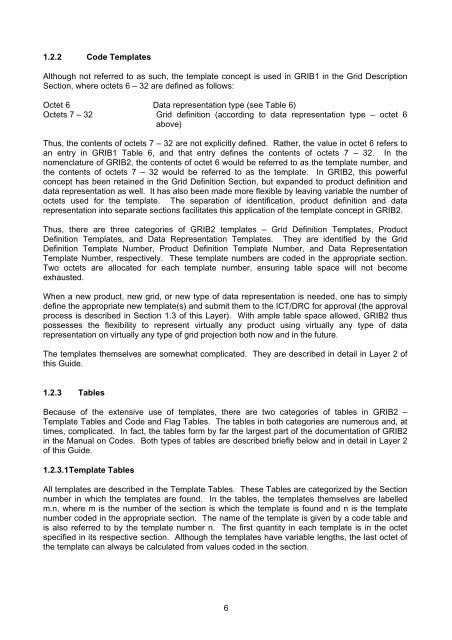Guide to WMO Table Driven Code Forms
Guide to WMO Table Driven Code Forms
Guide to WMO Table Driven Code Forms
Create successful ePaper yourself
Turn your PDF publications into a flip-book with our unique Google optimized e-Paper software.
1.2.2 <strong>Code</strong> Templates<br />
Although not referred <strong>to</strong> as such, the template concept is used in GRIB1 in the Grid Description<br />
Section, where octets 6 – 32 are defined as follows:<br />
Octet 6 Data representation type (see <strong>Table</strong> 6)<br />
Octets 7 – 32 Grid definition (according <strong>to</strong> data representation type – octet 6<br />
above)<br />
Thus, the contents of octets 7 – 32 are not explicitly defined. Rather, the value in octet 6 refers <strong>to</strong><br />
an entry in GRIB1 <strong>Table</strong> 6, and that entry defines the contents of octets 7 – 32. In the<br />
nomenclature of GRIB2, the contents of octet 6 would be referred <strong>to</strong> as the template number, and<br />
the contents of octets 7 – 32 would be referred <strong>to</strong> as the template. In GRIB2, this powerful<br />
concept has been retained in the Grid Definition Section, but expanded <strong>to</strong> product definition and<br />
data representation as well. It has also been made more flexible by leaving variable the number of<br />
octets used for the template. The separation of identification, product definition and data<br />
representation in<strong>to</strong> separate sections facilitates this application of the template concept in GRIB2.<br />
Thus, there are three categories of GRIB2 templates – Grid Definition Templates, Product<br />
Definition Templates, and Data Representation Templates. They are identified by the Grid<br />
Definition Template Number, Product Definition Template Number, and Data Representation<br />
Template Number, respectively. These template numbers are coded in the appropriate section.<br />
Two octets are allocated for each template number, ensuring table space will not become<br />
exhausted.<br />
When a new product, new grid, or new type of data representation is needed, one has <strong>to</strong> simply<br />
define the appropriate new template(s) and submit them <strong>to</strong> the ICT/DRC for approval (the approval<br />
process is described in Section 1.3 of this Layer). With ample table space allowed, GRIB2 thus<br />
possesses the flexibility <strong>to</strong> represent virtually any product using virtually any type of data<br />
representation on virtually any type of grid projection both now and in the future.<br />
The templates themselves are somewhat complicated. They are described in detail in Layer 2 of<br />
this <strong>Guide</strong>.<br />
1.2.3 <strong>Table</strong>s<br />
Because of the extensive use of templates, there are two categories of tables in GRIB2 –<br />
Template <strong>Table</strong>s and <strong>Code</strong> and Flag <strong>Table</strong>s. The tables in both categories are numerous and, at<br />
times, complicated. In fact, the tables form by far the largest part of the documentation of GRIB2<br />
in the Manual on <strong>Code</strong>s. Both types of tables are described briefly below and in detail in Layer 2<br />
of this <strong>Guide</strong>.<br />
1.2.3.1 Template <strong>Table</strong>s<br />
All templates are described in the Template <strong>Table</strong>s. These <strong>Table</strong>s are categorized by the Section<br />
number in which the templates are found. In the tables, the templates themselves are labelled<br />
m.n, where m is the number of the section is which the template is found and n is the template<br />
number coded in the appropriate section. The name of the template is given by a code table and<br />
is also referred <strong>to</strong> by the template number n. The first quantity in each template is in the octet<br />
specified in its respective section. Although the templates have variable lengths, the last octet of<br />
the template can always be calculated from values coded in the section.<br />
6

















